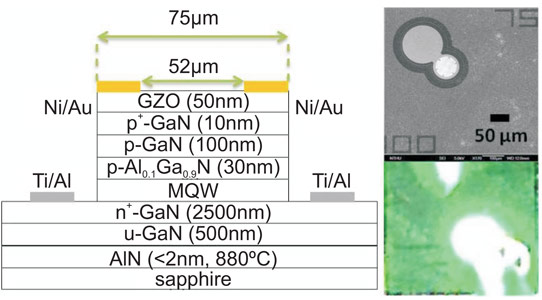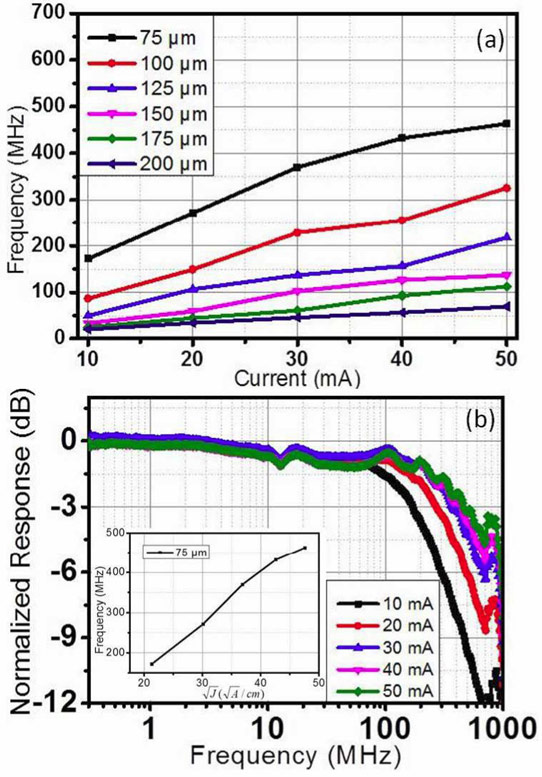- News
1 May 2014
Wider-band modulation of blue-green light-emitting diode
Taiwan’s National Tsing Hua University has claimed the highest optical 3dB modulation bandwidth of ∼463MHz at 50mA for a 500nm-wavelength blue-green indium gallium nitride (InGaN) LED [Chien-Lan Liao et al, IEEE Electron Device Letters, vol35, p563, 2014].
Modulation of such ‘green’ light is proposed for short-haul data links using low-cost polymethyl methacrylate (PMMA) plastic optical fiber, which has a lower attenuation coefficient and less temperature sensitivity at 500nm wavelengths compared with conventional red sources emitting at 650nm. The researchers also see potential for wireless visible light communication (VLC).
The epitaxial structure for the device (Figure 1) was grown using metal-organic chemical vapor deposition (MOCVD) on c-plane sapphire. The ~90nm active region consisted of five 2.5nm InGaN multiple quantum wells (MQWs) in 14nm GaN barriers. The LED was constructed with a ring-shaped electrode on gallium-doped zinc oxide (GZO) transparent conductor.

Figure 1: Green LED structure. Insets show top views of LED biased at 1mA injection current observed by field-emission scanning electron microscopy (FE-SEM, JSM-7000F) and optical microscopy.
The chip size was 380μmx380μm. The fabricated LED substrate was thinned from 425μm to 200 μm to improve die singulation and thermal conductivity. The chips were mounted in TO-46 headers without encapsulation.
Different devices with aperture diameters between 75μm and 200μm were produced. The turn-on voltage for all devices was about 2.8V. The peak wavelength was around 500nm, giving a blue-green color. The series resistance of the 75μm device was 14.5Ω and the capacitance under -5V reverse bias was 4.8pF. The other devices had smaller series resistance but larger capacitances. For high speed, one needs low resistance and capacitance.
The light output powers at 50mA injection current varied from 1.6mW for 75μm aperture to 5.6mW for the 200μm aperture.
The 3dB modulation bandwidth (f3dB, Figure 2a) was 463MHz at 50mA bias for a 75μm aperture. This reduced to 70MHz with 200μm aperture. For current biases between 10mA and 50mA, f3dB was proportional to the square root of the current density for 75μm aperture (Figure 2b). The relation is more complicated with wider apertures.

Figure 2: (a) Frequency f3dB response as function of forward current for LEDs with different aperture diameters. (b) Basis for f3dB measurement at different currents for the LED with a mesa diameter of 75μm. Inset shows frequency response as function of square root of current density.
These results compare with other groups that have achieved ‘green’ LEDs with bandwidths of 120MHz (50mA current bias, ~500nm wavlength) and 420MHz (520nm true green wavelength).
blue-green LEDs InGaN InGaN quantum well MOCVD
http://ieeexplore.ieee.org/xpl/articleDetails.jsp?arnumber=6786982
The author Mike Cooke is a freelance technology journalist who has worked in the semiconductor and advanced technology sectors since 1997.


